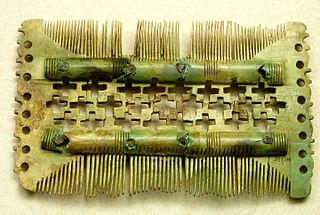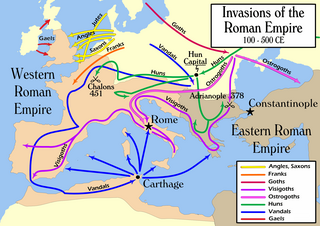
The Burgundians were an early Germanic tribe or group of tribes. They appeared in the middle Rhine region, near the Roman Empire, and were later moved into the empire, in eastern Gaul. They were possibly mentioned much earlier in the time of the Roman Empire as living in part of the region of Germania that is now part of Poland.

The Germanic peoples were tribal groups who lived in the north of Europe in Classical Antiquity and the Early Middle Ages. In modern scholarship, they typically include not only the Roman-era Germani who lived in both Germania and parts of the Roman empire, but also all Germanic speaking peoples from this era, irrespective of where they lived, most notably the Goths. Another term, ancient Germans, is considered problematic by many scholars since it suggests identity with present-day Germans. Although the first Roman descriptions of Germani involved tribes west of the Rhine, their homeland of Germania was portrayed as stretching east of the Rhine, to southern Scandinavia and the Vistula in the east, and to the upper Danube in the south. Other Germanic speakers, such as the Bastarnae and Goths, lived further east in what is now Moldova and Ukraine. The term Germani is generally only used to refer to historical peoples from the 1st to 4th centuries CE.

The Rugii, Rogi or Rugians, were one of the smaller Germanic peoples of Late Antiquity who are best known for their short-lived 5th-century kingdom upon the Roman frontier, near present-day Krems an der Donau in Austria. This kingdom, like those of the neighbouring Heruli and Scirii, first appears in records after the death of Attila in 453. The Rugii, Heruli, Scirii and others are believed to have moved into this region from distant homelands under pressure from the Huns, and become part of Attila's Hunnic empire which also moved and came to be based in this region. The Rugii were subsequently part of the alliance which defeated Attila's sons and the Ostrogoths at the Battle of Nedao in 454, giving their kingdom independence. In 469 they were part of a similar alliance who lost to the Ostrogoths at the Battle of Bolia, weakening their kingdom significantly.

The Thuringii, or Thuringians were a Germanic people who lived in the kingdom of the Thuringians that appeared during the late Migration Period south of the Harz Mountains of central Germania, a region still known today as Thuringia. The Thuringian kingdom came into conflict with the Merovingian Franks, and it later came under their influence and Frankish control as a stem duchy. The name is still used for one of modern Germany's federal states (Bundesländer).

The Migration Period, also known as the Barbarian Invasions, was a period in European history marked by large-scale migrations that saw the fall of the Western Roman Empire and subsequent settlement of its former territories by various tribes, and the establishment of the post-Roman kingdoms.

Germania, also more specifically called Magna Germania, Germania Libera, or Germanic Barbaricum to distinguish it from the Roman provinces of Germania Inferior and Germania Superior, was a historical region in north-central Europe during the Roman era, which was associated by Roman authors with the Germanic peoples. According to Roman geographers, this region stretched roughly from the Rhine in the west to the Vistula in the east, and to the Upper Danube in the south, and the known parts of southern Scandinavia in the north. Archaeologically, these people correspond roughly to the Roman Iron Age of those regions.

Gallia Belgica was a province of the Roman Empire located in the north-eastern part of Roman Gaul, in what is today primarily northern France, Belgium, and Luxembourg, along with parts of the Netherlands and Germany.

Bavarians are an ethnographic group of Germans of the Bavaria region, a state within Germany. The group's dialect or speech is known as the Bavarian language, native to Altbayern, roughly the territory of the Electorate of Bavaria in the 17th century.

Ripuarian or Rhineland Franks were one of the two main groupings of early Frankish people, and specifically it was the name eventually applied to the tribes who settled in the old Roman territory of the Ubii, with its capital at Cologne on the Rhine river in modern Germany. Their western neighbours were the Salii, or "Salian Franks", who were named already in late Roman records, and settled with imperial permission within the Roman Empire in what is today the southern part of the Netherlands, and Belgium, and later expanded their influence into the northern part of France north of the Loire river, creating the Frankish empire of Francia.
Germanic kingship is a thesis regarding the role of kings among the pre-Christianized Germanic tribes of the Migration period and Early Middle Ages. The thesis holds that the institution of feudal monarchy developed, through contact with the Roman Empire and the Christian Church, from an earlier custom of sacral and military kingship based on both birth status and consent from subjects.

This is a chronology of warfare between the Romans and various Germanic peoples. The nature of these wars varied through time between Roman conquest, Germanic uprisings, later Germanic invasions of the Western Roman Empire that started in the late second century BC, and more. The series of conflicts was one factor which led to the ultimate downfall of the Western Roman Empire in particular and ancient Rome in general in 476.

Roman Gaul refers to Gaul under provincial rule in the Roman Empire from the 1st century BC to the 5th century AD.

The Franks were a western European people during the Roman Empire and Middle Ages. They began as a Germanic people who lived near the Lower Rhine, on the northern continental frontier of the empire. They subsequently expanded their power and influence during the Middle Ages, until much of the population of western Europe, particularly in and near France, were commonly described as Franks, for example in the context of their joint efforts during the Crusades starting in the 11th century. A key turning point in this evolution was when the Frankish Merovingian dynasty based within the collapsing Western Roman Empire first became the rulers of the whole region between the rivers Loire and Rhine, and then subsequently imposed power over many other post-Roman kingdoms both inside and outside the old empire.
Kingdom of Burgundy was a name given to various states located in Western Europe during the Middle Ages. The historical Burgundy correlates with the border area of France and Switzerland and includes the major modern cities of Geneva and Lyon.

Barbaricum is a geographical name used by historical and archaeological experts to refer to the vast area of barbarian-occupied territory that lay, in Roman times, beyond the frontiers or limes of the Roman Empire in North, Central and South Eastern Europe, the "lands lying beyond Roman administrative control but nonetheless a part of the Roman world". During the Late Antiquity, it was the Latin name for those tribal territories not occupied by Rome that lay beyond the Rhine and the Danube : Ammianus Marcellinus used it, as did Eutropius. The earliest recorded mention appears to date to the early 3rd century.

The Lex Burgundionum refers to the law code of the Burgundians, probably issued by king Gundobad. It is influenced by Roman law and deals with domestic laws concerning marriage and inheritance as well as regulating weregild and other penalties. Interaction between Burgundians is treated separately from interaction between Burgundians and Gallo-Romans. The oldest of the 14 surviving manuscripts of the text dates to the 9th century, but the code's institution is ascribed to king Gundobad, with a possible revision by his successor Sigismund. The Lex Romana Burgundionum is a separate code, containing various laws taken from Roman sources, probably intended to apply to the Burgundians' Gallo-Roman subjects. The oldest copy of this text dates to the 7th century.

The Diocese of Gaul was a diocese of the later Roman Empire, under the praetorian prefecture of Gaul. It encompassed northern and eastern Gaul, that is, modern France north and east of the Loire, including the Low Countries and modern Germany west of the Rhine.

Warfare seems to have been a constant in Germanic society, and archaeology indicates this was the case prior to the arrival of the Romans in the 1st century BCE. Wars were frequent between and within the individual Germanic peoples. The early Germanic languages preserve various words for "war", and they did not necessarily clearly differentiate between warfare and other forms of violent interaction. The Romans note that for the Germans, robbery in warfare was not shameful, and most Germanic warfare both against Rome and against other Germanic peoples was motivated by the potential to acquire booty.

The contact between Germanic tribes and Romans can be divided into four aspects as defined by archaeologist Are Kolberg: the military, the trade, the gift, and the plunder aspect. All these aspects give probable answers as to how and why Roman objects got into Germanic hands, and why a vast amount of Roman objects still can be found as far north as Norway. It is noteworthy to understand how Roman objects brought elements of Roman culture with them, and how they to some extent shaped Germanic culture and identity.
The Germani cisrhenani, or "Left bank Germani", were a group of Germanic peoples who lived west of the Lower Rhine at the time of the Gallic Wars in the mid-1st century BC.
















